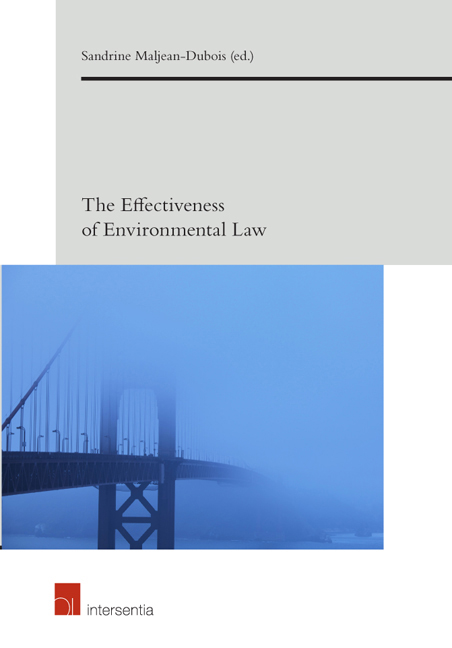Book contents
- Frontmatter
- Preface
- Contents
- Introduction. The Effectiveness of Environmental Law: A Key Topic
- Part 1 Measuring and Assessing Effectiveness
- Part 2 Improving Effectiveness
- Better Legislation
- Better Implementation
- Chapter 11 Towards More Effective Protection of Water Resources in Europe by Improving the Implementation of the Water Framework Directive and the Aarhus Convention in the Netherlands
- Chapter 12 Environmental Inspectors and Public Prosecutors. Is Sharing Information Always Useful?
- Chapter 13 Environmental Damage Caused by Oil Exploitation in Brazil. The “Conduct Adjustment Agreement” (TAC) as a Means to Circumvent Civil Liability Ineffectiveness
Chapter 14 - Can Multilateral Development Banks be More Environmentally Effective? Perspectives from the Practice of International Accountability Mechanisms
from Better Implementation
Published online by Cambridge University Press: 27 September 2018
- Frontmatter
- Preface
- Contents
- Introduction. The Effectiveness of Environmental Law: A Key Topic
- Part 1 Measuring and Assessing Effectiveness
- Part 2 Improving Effectiveness
- Better Legislation
- Better Implementation
- Chapter 11 Towards More Effective Protection of Water Resources in Europe by Improving the Implementation of the Water Framework Directive and the Aarhus Convention in the Netherlands
- Chapter 12 Environmental Inspectors and Public Prosecutors. Is Sharing Information Always Useful?
- Chapter 13 Environmental Damage Caused by Oil Exploitation in Brazil. The “Conduct Adjustment Agreement” (TAC) as a Means to Circumvent Civil Liability Ineffectiveness
Summary
The adverse environmental impacts of projects supported by Multilateral Development Banks (MDBs), such as the World Bank or its regional counterparts, have been denounced for decades. The domains in which MDBs operate logically bear environmental and social risk which can be significant: development of transportation, of agribusiness, of energy sources, of extractive industries etc. This includes projects to develop highways, airports, dams and reservoirs, irrigation systems, wind farms, coal power plants, mining, to reorganize land management, to reform the legal framework related to land tenures or else forest concessions etc. Such projects may entail changing land use patterns and natural habitats, or else cause disruptions affecting the water cycle, biodiversity, soil, forests … Not to mention the human impacts: ‘involuntary’ (in the language of MDBs) and sometimes unwanted resettlement, destruction of cultural or spiritual heritage, loss of livelihoods, forced evictions etc. The poor environmental record of the World Bank Group is richly documented, including by the World Bank itself, thanks to the reports of the Operations Evaluation Department, later transformed into the Independent Evaluation Group (IEG). For example, the 2001 OED Review of the Bank's Performance on the Environment notes that:
“To be sure, these achievements fell short of the expectations of many of its stakeholders. The momentum of the early 1990s dissipated in the face of constraints faced in the operating environment. Internally, environmental sustainability was not adequately integrated into the Bank's core objectives and country assistance strategies. Intellectually, the linkages between macroeconomic policy, poverty alleviation, and environmental sustainability were not explicitly forged. In sum, the institution's environmental efforts have not been consistent nor have they been held to uniform quality standards. Yet, staffhave carried out many worthwhile activities related to the environment (…) This OED report finds that the Bank has made progress on the environment, and notes that its commitments were not accompanied by precise goals and performance monitoring.”
In 2008, the IEG finds that:
“When requested, the Bank Group has been generally able to help countries set environmental priorities (although this is ultimately the responsibility of the countries themselves) and private sector clients to identify and address potential direct environmental impacts.
- Type
- Chapter
- Information
- The Effectiveness of Environmental Law , pp. 313 - 347Publisher: IntersentiaPrint publication year: 2017
- 2
- Cited by

